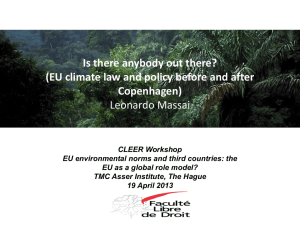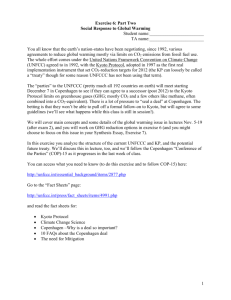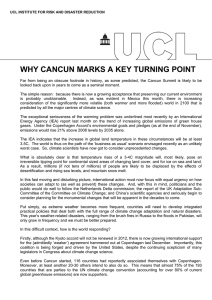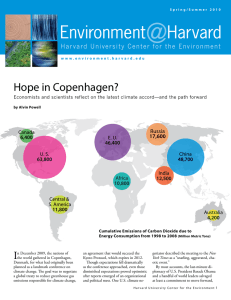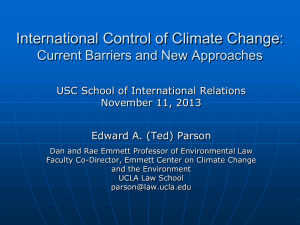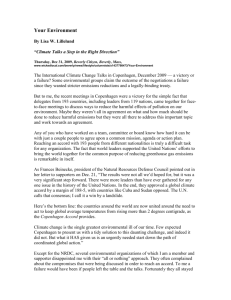ú International Climate Change Policy – From Copenhagen to Canc n, & Beyond
advertisement
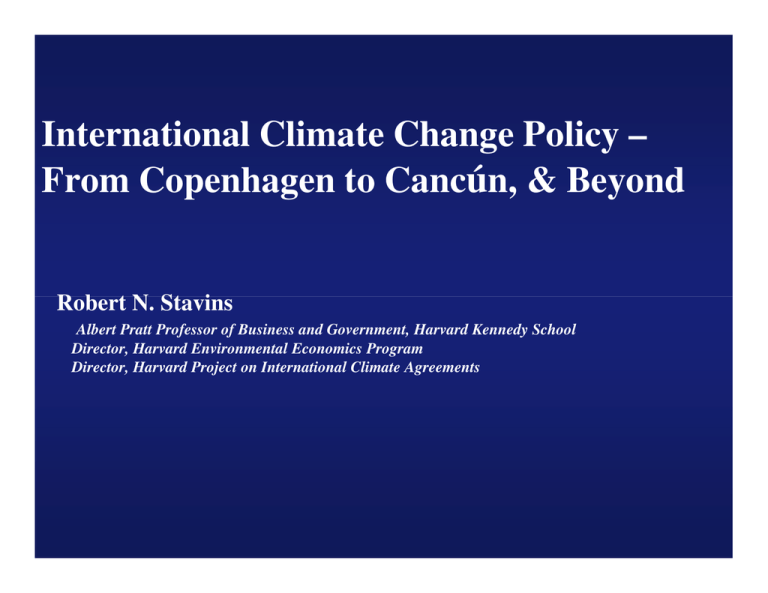
International Climate Change Policy – From Copenhagen to Cancún, & Beyond Robert RobertN. N.Stavins Stavins Albert Pratt Professor of Business and Government, Harvard Kennedy School Director, Harvard Environmental Economics Program Director, Harvard Project on International Climate Agreements The Global Climate Policy Challenge � Kyoto Protocol came into force in February 2005, with first commitment period, 2008-2012 � Even if the United States had participated, the Protocol’s direct effects on climate change would be very small to non-existent � Science and economics point to need for a credible international approach � Climate change is a classic global commons problem — so it calls for international (although not necessarily global) cooperation Can the Kyoto Protocol Provide the Way Forward? � The Kyoto Protocol has been criticized because: � The costs are much greater than need be, due to exclusion of most countries, including key emerging economies – China, India, Brazil, Korea, South Africa, Mexico (conservative estimate: costs are four times cost-effective level) � The Protocol will generate trivial climate benefits, and fails to provide any longterm solution � Short-term targets are excessively ambitious for some countries � So, the Kyoto Protocol is “too little, too fast” � Whether the Kyoto Protocol was a good first step or a bad first step, a next step is needed ….. Searching for the Path Forward for Post-2012 • The Harvard Project on International Climate Agreements • Mission: To help identify key design elements of a scientifically sound, economically scientifically economically rational, and politically pragmatic post-2012 international policy architecture for global climate change • Drawing upon research & ideas from leading thinkers around the world from: � � � � Academia (economics, political science, law, international relations) Private industry NGOs Please see Aldy, Joseph E., and Robert N. Stavins. Architectures for Agreement: Addressing Governments Global Climate Change in the Post-Kyoto World. Cambridge University Press, 2007. ISBN: 9780521692175. Developing Insights for Post-2012 Climate Regime • 35 research initiatives in Europe, United States, China, India, Japan, & Australia • Outreach with governments, NGOs, and business leaders throughout the world • Summary for Policymakers (2009) builds upon lessons emerging from research initiatives • Complete book with 30 chapters on principles, architectures, and design elements published by Cambridge University Press, January 2010 Please see Aldy, Joseph E., and Robert N. Stavins. Post-Kyoto International Climate Policy: Summary for Policymakers. Cambridge University Press, 2009. ISBN: 9780521138000. 5 Potential Global Climate Policy Architectures • Targets & Timetables (as in Kyoto Protocol) � Formulas for National Emission Targets • Harmonized National Policies • Independent National Policies � Portfolio of Domestic Commitments � Linkage of National & Regional Tradable Permit Systems 6 7 Formulas for National Emission Targets • Core: Key principles lead to design of targets � Formula used to set national emission caps to 2100 using three key elements � Progressivity factor: richer countries make more severe cuts � Latecomer factor: nations that did not achieve targets under Kyoto make gradual emission cuts to account for post-1990 emissions � Equalization factor: moves targets of all countries in direction of global average per capita emissions • FFormulas rmu as l ass assign gn i quant quantitative tat i ve i em emission ss i on i caps capstotocountr countries es i to 2100 � Developing countries are not asked to bear any cost in early years � Developing countries are not asked to make any sacrifice different from sacrifices of developed countries, accounting for differences in income � No countries have targets costing more than 1% of GDP • Every country contributes no more than its fair share Please see: Frankel, Jeffrey. "An Elaborated Proposal for Global Climate Policy Architecture: Specific Formulas and Emission Targets for All Countries in All Decades." Discussion Paper 08-08, Harvard Project on International Climate Agreements, October 2008. Portfolio of Domestic Commitments • Each participating nation registers to abide by its domestic climate commitments � Australia, EU, China, India, Japan, New Zealand, and U.S. announced domestic commitments or plans prior to Copenhagen (December 2009) • Also known as “pledge & review” or “schedules” • Support •• Support prior to Copenhagen from a diverse set of counties, including Australia, India, and the United States • But can this bring about sufficient stringency? � No • Can it be an effective bridge to further steps? � Yes Please see Stavins, Robert N. "A Portfolio of Domestic Commitments: Implementing Common but Differentiated Responsibilities." Policy Brief, Harvard Project on International Climate Agreements, October 19, 2009. 8 Linkage of National & Regional Tradable Permit Systems • Cap-and-trade systems are preferred approach in many countries and regions � Linking these cap-and-trade systems reduces overall costs, market power, and price volatility � But linking causes automatic propagation of cost-containment design elements: banking, borrowing, and safety valve � Therefore, advance harmonization required Please see • The Emerging International Regime • The Emerging International Regime � If cap-and-trade systems link with common emission reduction-credit system, such as CDM, the cap-and-trade systems are indirectly linked Jaffe, Judson, and Robert N. Stavins. "Linkage of Tradable Permit Systems in International Climate Policy Architecture." Discussion Paper 08-07, Harvard Project on International Climate Agreements, September 2008. � All the benefits of linking are achieved – cost savings, etc. � But propagation of design elements across systems greatly diminished � May be evolving as part of de facto post-Kyoto architecture 9 Placing COP 15 – Copenhagen – in Perspective � Cliché about American baseball season applies to international climate change policy: it’s a marathon, not a sprint � Scientifically: stock, not flow environmental problem � Economically: cost-effective path is gradual ramp-up in target severity (to avoid unnecessary capital-stock obsolescence) - term price � Economically: Economically: technological technological change change is is key, key, hence hence llong ong-term pricesignals signals � Administratively: creation of durable international institutions is essential � International climate negotiations will be an ongoing process – much like trade talks – not a single task with a clear end-point. � Bottom-Line: sensible goal for Copenhagen was progress on sound foundation for meaningful long-term action, not some notion of immediate “success” 10 What actually happened in Copenhagen? � Organizational failure (47,000 advance credentials – capacity of 15,000) � Lack of consensus � But last-minute, direct negotiations among key national leaders � Leaders of Brazil, China, India, South Africa, and the United States � Virtually unprecedented in international negotiations � Saved COP-15 from complete collapse � Produced a significant political framework, the Copenhagen Accord � Accord departs from Kyoto Protocol in two important ways: � (1) expands coalition of meaningful commitments to include all major emitters � (2) extends time-frame of action 11 The Copenhagen Accord � The “good news” � Provides for real cuts in greenhouse gas emissions by all major emitters � Establishes a transparent framework for evaluating countries’ performance against their commitments � Initiates a flow of resources to help poor, vulnerable nations carry out both mitigation and adaptation � Submissions Submissions received received from rom 140+ 140+ parties, parties, which which account for >80% of 2006 global emissions � The “bad news” � Not on track for 450 ppm (2o C) � Annex I/non-Annex I distinction remains, in words (but blurred in action) � Future of UNFCCC threatened (?) 12 Another Outcome of Copenhagen: Thinking About Institutions for Climate Governance � Copenhagen illustrated concerns with process under United Nations (Framework Convention on Climate Change – UNFCCC) �Size: 194 countries, countries, when 20 account for about 80% of g global lobal emissions �UN culture & process seems to polarize debate: developed vs developing world �UNFCCC de facto voting rule: unanimity required • Lack of consensus behind Copenhagen Accord due to objections of 6 of 194 countries (none major emitters) 13 Alternative Institutions for Climate Governance � Major Economies Forum – 80% of global emissions; initiated & led by U.S. � Australia, Brazil, Canada, China, European Union, France, Germany, India, Indonesia, Italy, Japan, Korea, Mexico, Russia, South Africa, United Kingdom, and United States � G20 – finance ministers; since 1999; have met on climate change � Countries of Major Economies Forum plus Argentina, Saudi Arabia, Turkey � Other multilateral (C30); bilateral, including China-U.S. � Other venues for specific aspects – example: World Bank & finance � UNFCCC – too soon for obituaries � Kyoto Protocol continues through 2012 � International legitimacy, and substantial constituency � In the meantime, U.S. (& Chinese) domestic policy action is critical ….. 14 Major Options for Climate Policy in the United States • Federal Policy � Pricing Instruments � Cap-and-Trade � Carbon Taxes � Other Instruments t � Regulation Regulation Under Unde the he Clean Clean Air Air Act Act � Energy Policies Not Targeted Exclusively at Climate Change � Public Nuisance Litigation � NIMBY and Other Interventions to Block Permits • Sub-National Policy � Regional, State, & Local Policies � National Linkage of Sub-National Policies 15 National Carbon-Pricing Policy • Most economists & other policy analysts favor this approach. Why? 1. No other feasible approach can provide truly meaningful emissions reductions (such as an 80% cut in national CO2 emissions by 2050) 2. It’s the least costly approach in short term (heterogeneous abatement costs) 3. It’s the least costly approach in the long term (incentive for carbon-friendly technological change) 4. It’s a necessary – but not sufficient – component of sensible climate policy 4. policy • But, carbon-pricing is a hot-button political issue � It makes the costs transparent (unlike conventional policy instruments), and is easily associated with the T-word; indeed, in Washington, cap-and-trade has been demonized as “cap-and-tax” � A meaningful, national, economy-wide carbon-pricing policy is unlikely to be enacted before 2013 • Does that mean there will be no Federal climate policy? No. 16 Cost-Effective Economy-Wide Climate Policy Achieves Very Different Reductions from Different Sectors from Reduction in Emissions fro m Baseline Level Percent Reduction in CO2 Emissions by Sector in 2030 Under an Economy-Wide Emissions Cap Yielding a $35/ton Allowance Price in 2030 (EIA) 40% 35% 30% 25% 20% 15% 10% 5% 0% Residential Commercial Industrial Transportation Electric Power Economy-Wide Anticipated Economic Impacts of U.S. Climate Policy � Cumulative cost, 2012-2030 – 0.3% to 0.9% of GDP � Oil market impacts relatively small � Essentially a tax on coal: coal price increases 280% relative to BAU (2030) • Coal � natural gas, then nuclear & renewables for electricity generation • Impact on gasoline price: increase of 9% (35¢/gal) relative to BAU (2030) • Gasoline demand: 5% fall below BAU by 2030 � Electricity sector accounts for 80%-90% of emissions reductions • Impacts on transportation sector & oil/heating relatively small (cost-effective) � Oil imports: 9% decrease below BAU by 2030 � But much more costly if other non-carbon-pricing options are pursued …. 18 Other Federal Regulations in Place or On the Way • U.S. Supreme Court decision, EPA endangerment finding, & CAA � Mobile source standards � Stationary sources (January 2, 2011, with or without “tailoring rule”) • Air pollution policies for correlated pollutants under CAA � Five rules in the regulatory pipeline – SOx, NOx, Hg, & PM � Could shut some coal plants (w/o any CO2 requirements) • Energy Policies (variety of standards & subsidies, not targeted at CO2) � National renewable electricity standard � Federal financing for “clean energy” projects � Energy efficiency measures 19 Other Legal Mechanisms • Public Nuisance Litigation � Lawsuits pursuing injunctive relief and/or damages � In flux – recent court decisions • Other Interventions � Intended to block permits for new fossil energy investments � Power plants � Transmission lines � Some NIMBY, some strategic • But, with delay in Congressional action on carbon-pricing, attention is increasingly turning to the states … 20 Sub-National Climate Policies • Regional, state, & local policies continue to emerge � Regional Greenhouse Gas Initiative (RGGI) � California’s Global Warming Solutions Act (AB 32) � Western Climate Initiative � In fact, more than half of 50 states are contemplating, developing, or implementing climate policies • In presence of Federal policy, …. � Will state efforts achieve their objectives? � Will state efforts be cost-effective? � Answer: interactions can be problematic, benign, or positive, … � depending on relative scope and stringency, and policy instruments used (Goulder & Stavins, NBER Working Paper 16123, June 2010) 21 U.S. Political Timing: A Challenge for the International Process � Recession (and unemployment) � Other domestic policy priorities: economic stimulus, health care, financial regulation, and the Gulf oil spill � Public perceptions � perceptions � Congressional deliberation, difficult politics, and challenging numbers � U.S. mid-term elections (November, 2010) work against bipartisanship, and make it more difficult to vote to raise energy prices � So, COP-16 in Cancún in December will surely be more enjoyable than COP­ 15 in Copenhagen, but can it be more productive? � Yes ……. 22 Defining Success at COP-16 1. Embrace parallel processes – MEF, G20, C30 – as input to UNFCCC process 2. Consolidate 3 tracks – KP, LCA, & CA – to 2 tracks (or even 1 track!) � KP – build on key elements, including “common but differentiated responsibilities,” but move beyond simplistic Annex I/non-Annex I distinction � Develop better methods for comparing targets and actions � Move forward with financing plans in CA 3. Focus on productive steps within specific narrow agreements, such as REDD 4. Develop sensible expectations and effective plans � Negotiations are an ongoing process, not a single task with a clear end-point � The most sensible goal for Cancún is not some notion of immediate triumph, but progress on sound foundation for meaningful long-term action. 23 For More Information Harvard Project on International Climate Agreements www.belfercenter.org/climate Harvard Environmental Economics Program www.hks.harvard.edu/m-rcbg/heep/ www.stavins.com MIT OpenCourseWare http://ocw.mit.edu 22.081J / 2.650J / 10.291J / 1.818J / 2.65J / 10.391J / 11.371J / 22.811J / ESD.166J Introduction to Sustainable Energy Fall 2010 For information about citing these materials or our Terms of Use, visit: http://ocw.mit.edu/terms.
